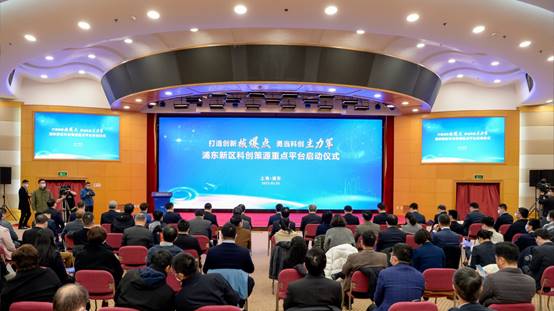Pudong endeavors to boost sci-tech innovation

A launch ceremony for key sci-tech innovation platforms in Pudong New Area, Shanghai, takes place on Feb 3. [Photo/chinadevelopment.com.cn]
As the pillar of scientific and technological innovation in Shanghai, Pudong New Area recently approved a new batch of Group Open Innovation (GOI) centers and launched a number of new scientific innovation platforms.
Eighteen GOI centers, including the China Mobile Shangyan Science and Technology Innovation Center, the Huada Semiconductor Automotive Electronic Chip Open Innovation Center and the Festo AX Innovation Center were unveiled at a launch ceremony on Feb 3, increasing the total number of GOI agencies to 65.
The Pudong government released its GOI plan in July 2021. The plan is part of its efforts to accomplish the mission assigned by the central government to turn Pudong into a pioneering force in the socialist modernization of China and to have it become a key engine in self-reliant innovation.
The GOI plan encourages industry leaders to set up open innovation platforms which will help foster a group of leading small and medium-sized tech enterprises and improve the environment for scientific research, technological innovation and entrepreneurship in Pudong, according to Wu Qiang, Pudong's deputy head.
Last year, Pudong witnessed a robust growth of its GOI plan, with 31 leading enterprises in various industries joining in. Through intensive cooperation between each GOI and its ecological partners, more than 2,200 small and medium-sized enterprises gained new growth drivers, and more than 1,000 achieved technological breakthroughs. The plan also attracted over 300 newly registered enterprises, and held more than 800 varied activities that were attended by 14,000 enterprises.
During the launch ceremony, the National Natural Science Foundation for Regional Innovation and Development Joint Fund for Urban Cooperation also officially started operation.
The joint fund has established a three-level cooperation mechanism involving the State, Shanghai and Pudong New Area. From 2023, governments at the three levels plan to invest a total of 120 million yuan ($18.3 million) each year for five consecutive years to solve key scientific issues and improve their basic research capacity.
The foundation has included one integration project and 11 key projects of Pudong this year covering integrated circuits, biomedicine, and artificial intelligence. The financial support for the projects totaled nearly 40 million yuan, accounting for about one third of that for all of Shanghai city.
In recent years, Pudong has made every effort to promote the construction of the core area of the International Science and Technology Innovation Center, build a Zhangjiang comprehensive national science center, promote the completion of many high-energy science and technology innovation platforms, and support the establishment of new local research and development institutions and key laboratories by domestic and foreign first-class scientific research institutions, colleges and universities, and science and technology enterprises.
Today, a number of forward-looking and strategic key platforms, such as the Shanghai Science and Education Base of the China University of Science and Technology and the Shanghai Zhangjiang Institute of Mathematics, have settled in Pudong, bringing with them the study of quantum science and technology, applied mathematics, and artificial intelligence, as well as industrial software development.

 Print
Print Mail
Mail




